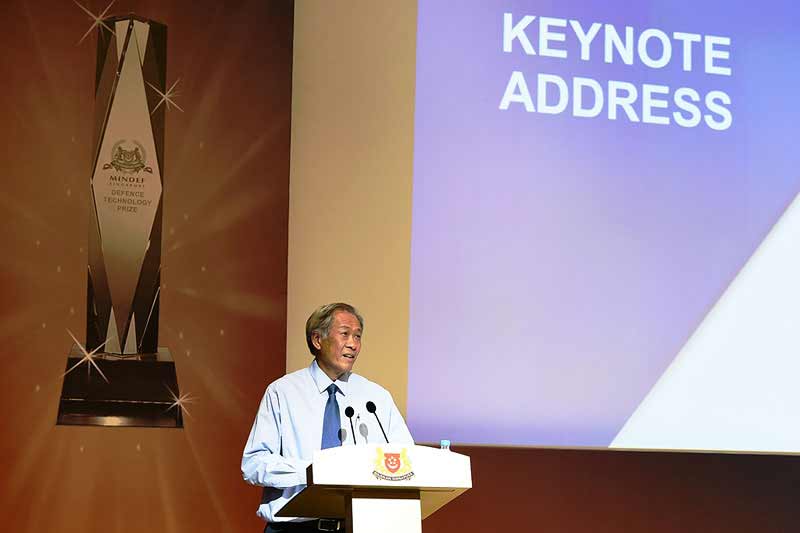
Above photo: Minister for Defence Dr Ng Eng Hen delivering speech at the Defence Technology Prize (DTP) 2017 Award Ceremony at DSO National Laboratories/ Credit: MINDEF
Singapore’s Minister for Defence, Dr. Ng Eng Hen, presented the Defence Technology Prize (DTP) to two individuals and five teams at an award ceremony held at the DSO National Laboratories on October 20. The individuals and teams are from Ministry of Defence (MINDEF) agencies – including the Defence Science and Technology Agency (DSTA) and the Defence Science Organisation (DSO), defence industry, academic and research institutes.
Established in 1989, the DTP is awarded annually to individuals and teams that have made significant technological contributions to the defence capability of Singapore. The DTP also serves to foster technological innovation and encourage breakthroughs in defence science and technology.
Team (Engineering)
The Army C4IT Team (DSTA, DSO National Laboratories, the Singapore Army and ST Electronics) won a Team (Engineering) award for the Secure Army Battlefield Internet (ABI), which integrates multiple Army command and control (C2) systems, radios and communication networks and allows Army commanders and frontline units to share information securely on the battlefield, improving common situational awareness and combat effectiveness.
The ABI connects all computer systems operated by the Singapore Army and is the backbone of communications on the battlefield. The team successfully upgraded and integrated different generations of Army communications equipment and networks, while also strengthening the overall cybersecurity of the ABI.
In delivering the ABI, the team revamped the Wide Area Communications network (WAC) to achieve a 17-fold increase in the speed of information exchange as compared to the analogue system that is still in service. The ABI now supports older C2 and voice-based systems that were not designed for interconnectivity. This gives soldiers access to a wider range of tools for faster, richer communications and more synchronised operations. It also extends the “shelf life” of existing systems, saving costs while posing minimal disruptions to Army operations.
The Digitised Trunk Communications System was also upgraded to let command posts send high-resolution videos and images during mission planning, as well as share data in real time with soldiers on the ground. Bandwidth upgrades to the satellite communications network further extended the reach and robustness of the WAC, without compromising on quality and speed of communications.
In addition, the team also developed new technologies for the ABI to improve communications at the tactical-level. The vehicle-mounted Software Defined Radio (SDR) system enables simultaneous voice and data communication among field troops and headquarters with four times more data capacity compared to the old system. No longer limited to just voice transmissions, soldiers can now send images and videos to build a clearer common situational picture. Introducing the SDR reduced the number of radios carried by tactical units by 50%, hence reducing the physical load on each soldier.
The team successfully delivered a new all-in-one integrated command post for commanders at Division and Brigade Headquarters, which are considered as the “nerve centres” of the Army. Equipment for command posts can now be loaded into one vehicle to be operated by four men, compared to two vehicles operated by twelve men previously. The team achieved this by tapping server virtualisation technology to reduce the amount of server space taken up by the Command and Control Information System, a C2 system that provides situational awareness among command posts. Thus, a single server resource can house multiple virtual servers, freeing up physical space.

The team delivered an advanced “Protect, Detect and Respond” cybersecurity capability for two ABI C4I systems — the Battlefield Management System and Advanced Combat Man System. This capability proactively monitors the C4I terminals’ status, automates authentication checks and provides real-time threat response, minimising the risks associated with information leakage.
The team also developed new encryption and cryptology methods to further ensure confidentiality and integrity of operational data. Conventional encryption standards were also modified by the team to facilitate faster encryption rates without compromising system security. An IP-based encryption technology was designed and developed that halved the number of encryption devices required, while laying the foundations for future integration of more advanced radio technology at the same time.
Operating the ABI requires a certain level of IT proficiency. To simplify the process, the team developed automated software for network set-up and management that allows soldiers to use the systems easily. For example, the Common Configuration Application software streamlines network planning processes for tactical combat radios and Battlefield Management Systems. Network settings are automatically configured for different missions and platforms.
As a result, the manpower requirements for network set-up for a Brigade were reduced by more than 60%. Similarly, the Resource Configuration Manager software automates set-up processes for command post trunk communications systems, reducing training time to set-up the networks by more than 60%.
Realisation of Integrated Networked Force Team (DSTA, DSO National Laboratories, the Republic of Singapore Air Force, the Republic of Singapore Navy, ST Aerospace, and ST Electronics) enabled interoperability across the different Services within the SAF, and offered opportunities for the SAF to develop transformational Air-Land-Sea concepts of operations.
The development of the integrated network has also provided all participants who have access to this network with a comprehensive picture of the battlespace situation. Such secure and seamless communications in the battlefield translates into increased operational effectiveness for the SAF.
Team (R&D)
The Advanced Information Security Team and the Advanced Information Security Analytics Team from the DSO National Laboratories and Singapore Armed Forces Joint Service, were recognised for the development of a complex information security system for the SAF and for analytics solutions respectively.
The Air Surveillance System Team from the DSO National Laboratories, DSTA, and the Republic of Singapore Air Force, won from developing an innovative and adaptable air surveillance system that can (i) detect small drones; (ii) be deployed in highly urban areas; and (ii) be interoperable with other sensors such as air traffic control, telecommunication, radio and television, coastal and satellite radars.
The Programme Manager of DSO National Laboratories explained, “Our surveillance system is extremely portable and scalable, making it suitable for any location and for a large area. Our system is also suited for use in an urban environment as it will not cause interference or be interfered by the existing radio waves emitted from systems such as televisions.”
Individual (R&D)
Mr. Phua is a communications and information security researcher and engineer with over 17 years of experience in developing indigenous capabilities in the analysis of security systems and a distinguished Member of Technical Staff at the DSO National Laboratories.
Leading multi-disciplinary teams, Mr. Melvin Phua, has delivered technological breakthroughs in securing the communications systems used in MINDEF and the Singapore Armed Forces (SAF). Through his active engagement with the industry, he has pioneered integrated approaches to the research into communications security. He continues to mentor individuals, develop teams and create tools to tackle the increasingly complex challenges faced in defence communications networks today.
Individual (Engineering)
Mr. Leong See Sum, Director (InfoComm Infrastructure), DSTA, played an instrumental role in the build-up of network capabilities in the MINDEF and SAF through the development of secure, robust and resilient design of the operational and administrative network systems in use today.
Mr. Leong has been working on using data analytics to carry out health monitoring of network equipment and fault analysis, and continues to find new ways to leverage technology to solve everyday problems.

“One example would be to use Artificial Intelligence to readily detect system failures through real-time analysis of data, which will provide greater manpower and cost savings,” he said.
His numerous innovations in the design of secured network systems have vastly improved network robustness and allowed for more effective and efficient network monitoring and maintenance at a reduced cost and manpower support. Some of the initiatives that he has led on MINDEF networks and mobility systems have allowed personnel to operate computer systems securely on the move.
One such initiative is the Camera Disabling Application, a mobile solution that allows personnel to disable the cameras of their mobile phones without physically removing or destroying any component. The solution is also integrated with building access systems, such that access is only granted when the phone camera is disabled. The solution provides greater flexibility for mobile device usage in defence facilities.
















